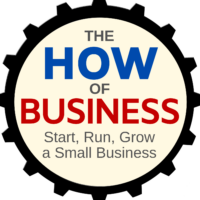![]()
Listener Q&A – Small Business Operations.
Listener Q&A – Small Business Operations: Henry Lopez answers listener’s small business questions related to small business operations.
This is a special Listener Small Business Question & Answer episode! We have gathered some of the great questions our listeners have submitted related to the on-going operations of a small business through the Listener Survey, and Henry answers these questions on this episode of the How of Business podcast.
This group of questions are about the operations of a business, from what it means to create processes and procedures to hiring and retaining the best staff for your small business.
Listener Q&A – Small Business Operations – Episode Index:
- [0:00] – Overview of the Components, Departments or Areas of Small Business Operations.
- [8:05] – What does it really mean to create Processes and procedures? Does everything have to be written down in a formal format?
- [21:14] – What are the Duties and Responsibilities of a Small Business CEO?
- [28:30] – How to hire the best talent? Where do you look and what does a small business offer to keep their talented employees?
Small Business Operations Questions & Answer Summary and Related Resources:
To evaluate your small business operations, consider these Typical Components or Departments or Areas of Small Business Operations. Perhaps give your business a score, on a scale of 1-5 to measure how you are performing in each of these key areas:
1. Production: Manufacturing or creating the products or services.
2. Supply Chain: Procurement, storage, and distribution of raw materials and finished goods.
3. Customer Support: Handling customer queries, complaints, and feedback.
4. Human Resources: Employee recruitment, training, payroll, and benefits.
5. Legal: Contracts, compliance, and risk management.
6. Facilities Management: Maintenance of physical (or virtual) workspaces and utilities.
7. Asset Management: Tracking and maintaining your physical assets like equipment or vehicles.
8. Information Technology: Software, hardware, and network management.
9. Finance and Accounting: Budgeting, invoicing, tax filing, and financial reporting.
Understanding and managing these areas effectively can help you run a smooth operation, which in turn can lead to business growth and profitability.
Listener Q&A – Small Business Operations – Listener Questions:
Asked by: Josh
Question: What does it really mean to create Processes and procedures? Does everything have to be written down in a formal format?
Answer:
-
- No, everything does not have to be formally documented in writing. Often a simple checklist, or a training video might be better.
- Consider starting with a process map of the customer’s journey. You can use PowerPoint or Google Slides. What are the high-level steps in the journey of the customer/client/patient as they interact with your business.
- Then identify where there are constraints or where specific performance is necessary. Start with those areas by creating the first version of your system which may include a process map, procedure, checklist, or other materials. Start with an outline. And remember, don’t try to create a “complete” or “perfect” final document – just start by creating version 1.
- Related Episode: 242: Small Business Systems with Henry Lopez
Asked by: William
Question: What are the Duties and Responsibilities of a Small Business CEO?
Answer:
-
- Vision and Strategy: Set the company’s overall vision, mission, and strategic direction. That may include developing and implementing strategic plans to advance you business’ mission and increase revenue, profitability, and growth.
- Operations and Management: Oversee daily operations to ensure they align with the strategic goals. This also includes hiring and leading a senior team, or leadership team, as your business grows.
- Financial Oversight: Oversee the company’s financial health, including budgeting, financial forecasting, and risk management. Ensure that financial goals are met, and make pivotal decisions on investments and cash management. You should get the help of your CPA on this. And as you grow larger you should consider hinting an Accounting Manager, who reports to you, and perhaps also engage a fractional CFO.
- Stakeholder Communications: Foster relationships with partners, suppliers, investors, key clients, partners, and other stakeholders. Act as the main spokesperson for the company, representing the business to clients, the media, and the public.
- Decision Making: Make major business decisions, often in collaboration with other members of the leadership team and business partners. Resolve any issues or crises faced by the company.
Related Episode: 245 – Two Responsibilities Small Business Owners Must Embrace (Decision Making and Accepting Personal Mistakes). - Culture and Team Leadership: Establish and foster company culture and vision. Guide and develop staff, fostering a positive and productive work environment. Related Episode: 436: Small Business Culture
- Business Development: Identify and tap into new business opportunities. Oversee the development of new products or services.
- Risk Management: Identify potential risks and ensure they are appropriately managed and mitigated. This may include Regulatory and Legal Oversight – Ensure all operations of the company are conducted within the framework of regulations, laws, and standards that apply to the business. Address and handle any legal issues your small business may be dealing with. Related Episode: 471 – Risk Management for Small Business with John Morlan
Asked by: Lissette
Question: How to hire the best talent? Where do you look and what does a small business offer to keep their talented employees?
Answer:
- Start with a well-defined Job Description. It should include the required skills, experiences, personal qualities, and any other important criteria.
- Research compensation. Are you competitive with your pay and benefits?
- For your job posting, remember to open with why a candidate should consider working for your organization. Sell them on your company or organization.
- Identify the top 3 to 5 most important qualifications, and prepare interview questions to help you uncover those.
- Learn how to get better at interviewing, and use different methods (i.e. multiple rounds, group interviews, presentations, in-person, casual setting in-person). Ask good questions that you prepare beforehand. Ask “how did you” not “how would you”.
To keep your talent at your small business or organization:
- On-board the employee correctly.
- Give them the on-going training and coaching they need and want.
- Give them regular coaching and feedback – both formal and informal.
- Recognize their achievements. Shares that recognition with other team members as appropriate.
- Implement and execute a formal performance program with regular formal reviews of feedback.
- Provide opportunities for contribution and making an impact, both inside the company and in the community.
- Provide opportunity for development and self-improvement.
- Foster and nurture a positive culture and fair work environment.
Related Episodes:
Asked by: Andy
Question: How do you determine if your long-time employee is really what is holding you back, even if they are a key role player in the day to day work?
Answer:
- Assess Performance Metrics – what are the specific performance issues with this employee?
- Productivity: Compare the employee’s output and efficiency over time. Has it declined or plateaued?
- Quality of Work: Evaluate the quality of the work they produce. Are there frequent errors or lapses?
- Team Performance: Consider the overall performance of the team or department they are part of. Is it underperforming?
- Evaluate Soft Skills, including:
- Communication: Does the employee communicate effectively with team members and management?
- Leadership: If applicable, how well do they lead and inspire their team?
- Adaptability: Are they open to change and new ways of doing things?
- Alignment: Does the employee’s behavior and attitude align with the company’s culture and values?
- Morale: Does the employee contribute positively or negatively to team morale?
- Peer Reviews: Anonymous peer reviews can provide insights into teamwork and interpersonal skills.
- Feedback: If applicable, consider feedback from clients or customers who interact with the employee. You might also consider engaging a business mentor or coach to help you with this employee assessment.
- Management Team: Discuss your concerns with other members of the management team to get their perspective.
- HR Consultation: Consult your HR department and your attorney for guidance on how to approach the situation, especially if you’re considering termination.
- Performance Review: Conduct a formal performance review to discuss your observations and concerns.
- Development Plan: If shortcomings are identified that perhaps can be corrected, create a development plan with clear objectives and timelines.Remember, it’s crucial to approach this delicately to maintain a positive work environment and to comply with employment laws. Consulting with HR and possibly legal counsel is advisable.
Listener Q&A – Small Business Operations – Listener Survey:
Please help us make The How of Business podcast even better by completing the listener survey.
Other Podcast Episodes:
You can find other episodes of The How of Business podcast, the best small business podcast, on our Archives page.
Sponsors:
This episode of The How of Business podcast is sponsored by Relay.
Special offer for The How of Business listeners, sign up for Relay using this link and you’ll also get $50 added to your account once you fund your new account.
This episode of The How of Business podcast is sponsored Relay. Relay is an online banking and money management platform for small business.
As a small business owner, you need banking that’s truly built for your small business. No more fees. No minimum balances. No more bookkeeping problems come tax season. And no more branch visits to complete basic banking tasks.
Now you can take control of your money with Relay, an online banking and money management platform that puts you in complete control of your cash flow.
First, there are no account fees, no overdraft fees, and no minimum balances, which means you get to keep more of your hard-earned money.
And Relay is the official banking partner for Profit First. So you can set up multiple checking and savings accounts and automate their percentage-based allocations using smart transfer rules.
Relay also allows you to:
- Make unlimited payments via ACH, wires or checks.
- Earn interest on every spare dollar with Relay savings accounts.
- Provide secure, read-only access to your accountant and bookkeeper.
- And speed up bookkeeping with reliable bank feeds that sync directly into QuickBooks Online and Xero.
Best of all, it takes less than 10 minutes to apply online and it’s absolutely FREE!
Special offer for The How of Business listeners, sign up for Relay using this link and you’ll also get $50 added to your account once you fund your new account.
Relay customer deposits are FDIC Insured through their partner bank, Thread Bank, member FDIC. Relay is a financial technology company, not an FDIC-insured bank. Banking services and FDIC insurance provided through Evolve Bank & Trust and Thread Bank; Members FDIC. The Relay Visa® Debit Card is issued by Thread Bank pursuant to a license from Visa U.S.A. Inc. and may be used everywhere Visa® debit cards are accepted.
We have received compensation from this sponsor partner. We only accept sponsorships from companies who we believe provide products and services that are valuable for small business owners.



